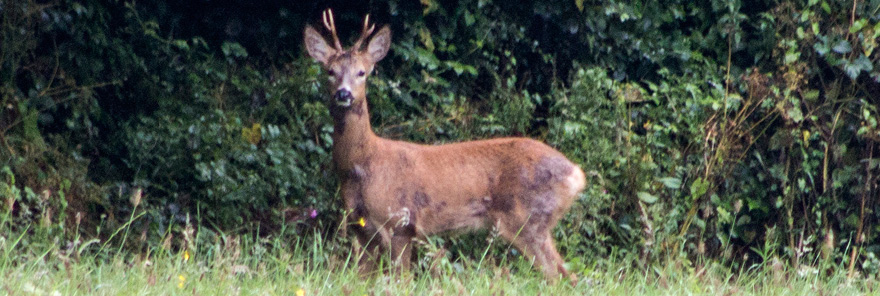Sharing our farms with wildlife is one of the privileges of country living. Farms serve a vital role in providing green space and habitat to a wide variety of animals who might not find places to survive in suburbs and urban spaces. But it comes with challenges–how do we keep our horses and other domestic animals safe from hazards wildlife might bring? And how do we protect wildlife which might be squeezed out of habitat by construction elsewhere?
Native animals: Animals granted wide-ranging habitats are more genetically diverse, which is good for the species overall. Even if your farm is a well-groomed and landscaped showplace, your property might still be a way-station between two woodland or grassland habitats for a variety of species, from deer to songbirds. Give them some grub along the way by planting some snacks: sunflowers are a beautiful choice.
Most woodland animals rely heavily on seeds, nuts, and acorns for sustenance, especially through the winter. Unfortunately, many of the trees they love aren’t exactly horse-friendly. Even oaks, a common tree throughout North America and the producer of the nutritionally valuable acorn, can cause trouble for horses — oak buds and green acorns can produce renal toxicity. Still, if you have space on your farm not dominated by pasture, you can invite animals to the buffet by planting nut-bearing trees like beech and hickory. You can also provide shelter for birds that looks great along your road frontage and barn by planting hedges.
Winged Invaders: You can welcome birds to your farm, but you don’t have to invite them inside. Many birds who love to roost in barns are invaders from another continent. Pigeons and starlings are two common invaders who will happily take over a barn’s rafters, which can lead to health concerns for the horses and people below. Since most birds are protected by state and federal laws, keeping birds out of your barn is best approached as a matter of prevention.
Birds are lured to barns by food. Grain spills, even the oats your horse drops from his morning sweet feed and doesn’t clean up, are a siren song for birds. Keep grain cleaned up and covered up in bird-proof containers. Keep waterers from being too bird-friendly, too, maintaining a depth that’s too deep for birds to stand in, and too far from the top lip of the trough or bucket for birds to lean down for a drink.
If unwanted birds are nesting in your barn, covering the rafters with netting can block their access to coveted perches. You can also block your open eaves with wire mesh which still allows for plenty of air-flow.
You’ll find many more fixes for birds in your barn at the Penn State’s extension website: http://extension.psu.edu/natural-resources/wildlife/wildlife-nuisance-and-damage/birds/wildlife-damage-control-16-controlling-birds-around-farm-buildings.
As farmers, we have a unique opportunity to offer green-space to animals whose habitats are choked out by most other forms of commerce. Offering them food and safe spaces to live, and humanely blocking them out of the places we don’t want them (our barns!) contributes to ensuring the survival of many species. We also have the pleasure of enjoying the presence of nature around our farms. What a wonderful privilege!


